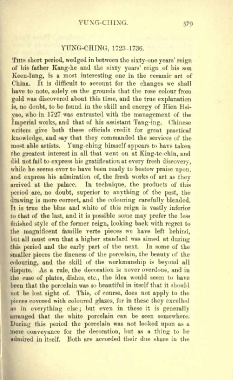Page 283 - Chinese Porcelain Vol II, Galland
P. 283
YUNG-CHING. 379
YUNG-CHING, 1723-1736.
THIS short period, wedged in between the sixty-one years' reign
of his father Kang-he and the sixty years' reign of his son
is a most one in the ceramic art of
Keen-lung, interesting
China. It is difficult to account for the changes we shall
on the that the rose colour from
have to note, solely grounds
gold was discovered about this time, and the true explanation
is, no doubt, to be found in the skill and energy of Hien Hsi-
who in 1727 was entrusted with the of the
yao, management
Imperial works, and that of his assistant Tang-ing. Chinese
writers both these officials credit for
give great practical
and that commanded the services of the
knowledge, say they
most able artists. Yung-ching himself appears to have taken
the interest in all that went on at
greatest King-te-chin, and
did not fail to express his gratification at every fresh discovery,
while he seems ever to have been ready to bestow praise upon,
and express his admiration of, the fresh works of art as they
arrived at the palace. In technique, the products of this
period are, no doubt, superior to anything of the past, the
drawing is more correct, and the colouring carefully blended.
It is true the blue and white of this reign is vastly inferior
to that of the last, and it is possible some may prefer the less
finished of the former reign, looking back with to
style regret
the famille verte we have left behind,
magnificent pieces
but all must own that a higher standard was aimed at during
this and the of the next. In some of the
period early part
smaller the fineness of the the of the
pieces porcelain, beauty
and the skill of the is all
colouring, workmanship beyond
As a rule, the decoration is never overdone, and in
dispute.
the case of plates, dishes, etc., the idea would seem to have
been that the was so beautiful in itself that it should
porcelain
not be lost of. This, of course, does not apply to the
sight
covered with coloured for in these excelled
pieces glazes, they
as in everything else ; but even in these it is generally
arranged that the white porcelain can be seen somewhere.
During this period the porcelain was not looked upon as a
mere conveyance for the decoration, but as a thing to be
admired in itself. Both are accorded their due share in the

